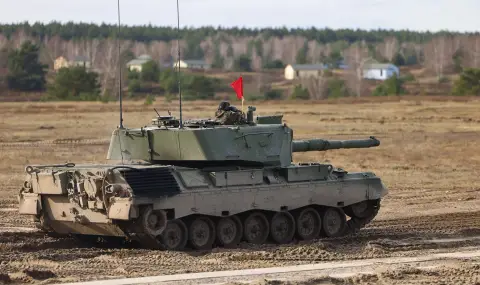A meeting was held at the military sergeant school in Delitzsch, Saxony, where future commanders in the Bundeswehr are trained, with the deputy military attaché of the German embassy in Kiev, who described in a surprisingly clear and undiplomatic manner the experience that the Ukrainians have with the German military equipment provided to them, reports the public media ARD.
Technical problems, too little ammunition
A classified transcript of the presentation, which was obtained by the public media WDR and NDR, as well as the newspaper “Süddeutsche Zeitung“ (ZT), lists eight weapons systems that Germany has provided to Ukraine. Here is what the confidential document says:
- The technical problems with the self-propelled howitzer 2000 are so numerous that they even call into question its fundamental suitability for use in real combat conditions.
- In general, the "Leopard 1A5" tank is considered reliable, but due to its weak armor it is "often used only as auxiliary artillery". And the newer "Leopard 2A6" requires expensive repairs, which often cannot be carried out on site, i.e. at the front.
- The IRIS-T air defense system is very effective, but the ammunition for it is not only too expensive, but also extremely insufficient in availability.
- The "Patriot" missile complex while, which is in principle a “superb weapons system“, is unsuitable for use in war, since the vehicle carrying the installation is “too old, and the manufacturer no longer supplies spare parts“, the protocol in question says.
Sobering conclusions
The military diplomat's conclusion sounds quite sobering: “Almost no German large-scale equipment is fully fit for war.“ The report also draws another conclusion: “Sophisticated equipment remains unused (...) The operational value of ultra-modern and complex large-scale equipment remains low if troops cannot carry out repairs on site“.
According to Bundeswehr sources, Ukraine is in a special situation: the fact that in recent years many Western countries have supplied various equipment has forced the Ukrainian armed forces to improvise to a large extent. They lack experience in working with Western weapons systems, and soldiers often undergo only abbreviated training in their operation.
On the other hand, it cannot be denied that on the battlefields of Ukraine, these weapons systems, which until now have served the Bundeswehr mainly for training, are currently being tested in real combat conditions. They were also developed long ago for other times, when drones were not used as widely as they are now.
One example: because of the threat posed by these unmanned aerial vehicles, the repair of a damaged tank cannot be carried out near the front line, explains the ARD. The repair teams that Western arms companies such as Rheinmetall also support in Ukraine are located in the western part of the country, far from the front line, or in neighboring countries such as Poland, the ARD publication specifies. This means that damaged large equipment can hardly be repaired at the front.
Germany could also face these problems
In Bundeswehr circles, it is assumed that in the event of war, Germany could also face problems similar to those in Ukraine. However, it is expected that the framework conditions will be significantly better in Germany – due to the availability of more reliable support, trouble-free logistics, including shorter delivery times for equipment, spare parts, etc.
And in an emergency situation, for example, if Russia attacks one of the Baltic states, Article 5 of the NATO Collective Defense Treaty would be triggered and the Bundeswehr may have to participate in military operations.
The ARD publication also says that both Rheinmetall and other German arms companies have refused to comment to WDR, NDR and “Süddeutsche Zeitung“ on the problems in using the aforementioned German weapons systems.
Bureaucratic obstacles
Although Ukrainian personnel are also trained to repair the machines, it often takes months before this happens - for example, with howitzers. According to representatives of the Bundeswehr, this is often due to the lack of spare parts, and the German bureaucracy with its complex and lengthy procedures for issuing licenses for the export of military equipment makes things even more difficult. For example, it has long been known that the Tank Howitzer 2000 is a vulnerable system: reports from Ukraine speak of frequent software problems, but also technical ones - the gun barrel quickly overheats, which requires its replacement. Overall, however, the howitzer is considered a powerful and precise weapon system, ARD specifies.
The transcript of the presentation by the German military diplomat in Kiev also makes it clear that older German weapon systems are particularly valued in Ukraine - namely those that the Bundeswehr has already decommissioned. The anti-aircraft armored vehicle "Gepard", which is used primarily against Russian drones and cruise missiles, is considered "the most popular, effective and reliable weapon system", according to the document. And about the infantry tank "Marder", the military attaché says the following: "A very popular combat vehicle, used without restrictions".
"Massive, but also high-tech" weapons are needed
„However, this does not mean that in the future we should abandon modern high-tech weapon systems", says the o.z. General Hans-Lothar Domröse: "We need both: mass and high-tech", he tells ARD.
One of the important conclusions from Ukraine is named by Greens' security spokeswoman Sarah Nanni: Since the risk of failure of modern and much more complex equipment is higher, we need to have more weapons systems available. "We can no longer think in the current framework of small available quantities. Rather, we must assume that these systems have a long service life and must be maintained even after failure and repair."
Authors: Florian Flade ARD | Tamara Antoni ARD | Rajko Pinkert ARD
